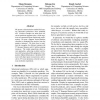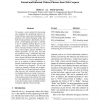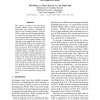EMNLP
2008
14 years 29 days ago
2008
The performance of machine translation systems varies greatly depending on the source and target languages involved. Determining the contribution of different characteristics of l...
EMNLP
2008
14 years 29 days ago
2008
We present a discriminative method for learning selectional preferences from unlabeled text. Positive examples are taken from observed predicate-argument pairs, while negatives ar...
EMNLP
2008
14 years 29 days ago
2008
We present a novel method for discovering and modeling the relationship between informal Chinese expressions (including colloquialisms and instant-messaging slang) and their forma...
EMNLP
2008
14 years 29 days ago
2008
A human annotator can provide hints to a machine learner by highlighting contextual "rationales" for each of his or her annotations (Zaidan et al., 2007). How can one ex...
EMNLP
2008
14 years 29 days ago
2008
The accuracy of current word sense disambiguation (WSD) systems is affected by the fine-grained sense inventory of WordNet as well as a lack of training examples. Using the WSD ex...
EMNLP
2008
14 years 29 days ago
2008
Obtaining labeled data is a significant obstacle for many NLP tasks. Recently, online games have been proposed as a new way of obtaining labeled data; games attract users by being...
EMNLP
2008
14 years 29 days ago
2008
We consider a parsed text corpus as an instance of a labelled directed graph, where nodes represent words and weighted directed edges represent the syntactic relations between the...
EMNLP
2008
14 years 29 days ago
2008
We present a generative model for unsupervised coreference resolution that views coreference as an EM clustering process. For comparison purposes, we revisit Haghighi and Klein�...
EMNLP
2008
14 years 29 days ago
2008
Most attempts to integrate FrameNet in NLP systems have so far failed because of its limited coverage. In this paper, we investigate the applicability of distributional and WordNe...
EMNLP
2008
14 years 29 days ago
2008
String-to-string transduction is a central problem in computational linguistics and natural language processing. It occurs in tasks as diverse as name transliteration, spelling co...



